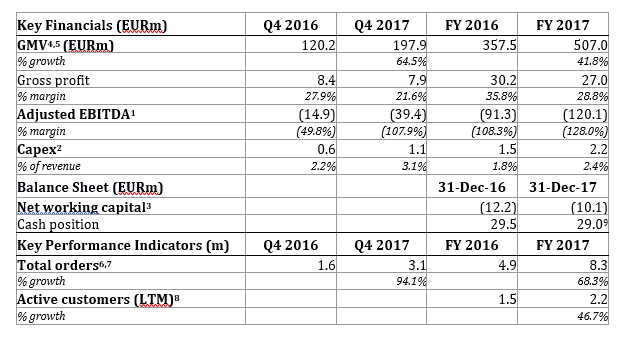Limelight Networks (Nasdaq: LLNW), a global leader in digital content delivery, has announced the opening of a new Point-of-Presence (PoP) in South Africa, to drive Limelight’s commitment to building out infrastructure globally and create new industry partnerships in the region. The new PoP is situated at vendor neutral data centre Teraco, alongside Africa’s largest Internet Exchange (IXP), NAPAfrica Johannesburg.
Limelight’s expansion into Africa follows positive signs of online traffic growth within the continent. According to reports, the global mobile Content Delivery Network (CDN) market is predicted to reach $70.3 billion by 2025. This is indicative of the continued growth of online video content, increasing use of internet services and the rise of mobile web access.
Lex Van Wyk, CEO of Teraco said,
“CDNs already host a large proportion of global internet traffic and it’s predicted that in five years CDN traffic will exceed 70 percent of total online traffic, making it the new Internet. Limelight is a top global CDN and we are excited to see the impact of their investment into Africa.”
Teraco’s facilities offer a diverse interconnection hub and the company is focused on local Internet growth and expansion via NAPAfrica Johannesburg, providing a platform for Limelight to deliver fast, high-quality and scalable online traffic to countries across sub-Saharan Africa for its local and global customers.
“Movies, music and sports are the foundation of digital content for most countries, and South Africa is no different,”
said Simon Beech, Head of EMEA Partnerships at Limelight Networks.
“The decision to address the African market with further infrastructure investment is directly related to the rapidly growing demand for CDN services and capabilities locally. As connectivity improves, it is essential to provide the highest quality online experiences to stay competitive. We look forward to bringing a range of exciting new services to the region through local sales partnerships.”
Related Topics Best Data Plans Best Data Plans in Nigeria Glo Data Plan Etisalat Data Plan Airtel Data Plan MTN Data PlanThe post Limelight Networks partners Teraco, Expands CDN Capacity with a new Point of Presence in Africa appeared first on Nigeria Technology Guide.
Jumia – currently holding the position of the leading online marketplace in African countries – has posted its financial results for the last quarter (Q4) of 2017 and full year 2017 and they are showing no signs of slowing down.
The company has been around for a while now and despite the fact that they had no infrastructure to build on, has managed to establish itself as the go-to e-commerce provider in the country.
One of the biggest highlights of the company’s financial report is their GMV growth which soared by a massive 64.5% in the fourth quarter alone.

Comparing these figures with a year on year basis, the company saw a return of 120.2 million EUR in the fourth quarter of 2016 as against 197.9 MEUR in Q4 2017. The number of order on Jumia also grew 94% year on year in the fourth quarter. This helped Jumia achieve a 46% growth in GMV for the full 2017.
Jumia was quick to be appreciative of everyone making use of their platforms in this growth drive. Quite frankly, those thanks are due since they could not have made any of these happen without the help of merchants and active participants thanks to innovative services like Jumia Express. It is also worthy of note that in the one-year period from Q4 2016 – 2017, there has been a massive increase in the number of products and services being offered on the platform.
Sacha Poignonnec and Jeremy Hodara, Jumia co-CEOs commented:
“We made great progress in 2017 with significant growth of the business, driven by technological innovations and improved relevance of the offering of goods and services. This growth is demonstrating the robust momentum in our core businesses and markets, and the increased adoption of online services by African consumers. We are also seeing good results from our strategy to further develop our logistics platform and our payment platform. Our customers continue to benefit from increasing access to great services, quality products, improved customer experience and the tremendous convenience of being able to shop online”.
With the eCommerce market generally far from saturation, we can hope for even bigger changes in the future.
Putting our words into numbers, Jumia has grown from a platform that housed just 50,000 products in the year 2012 to one that is now cataloguing no less than 5 million products as at the year-ended 2017.
In that same time frame, the company recorded over 100 million engagements during its largely successful Jumia Black Friday deals sales day. As if that was not enough, they have now been able to introduce their very own payment system (Jumia Pay) to ensure users are able to make complete transactions on their orders seamlessly.
If they stopped there, this resume would still be impressive. However, Jumia went over and beyond in bringing up Jumia One – a service which allowed users access digital transactions such as bills payment, buying airtime and so much more.
 Jumia Financial Report Q4 2017 and Full Year 2017 Detailed Table
Jumia Financial Report Q4 2017 and Full Year 2017 Detailed Table
Handling more than 8 million packages through their logistics department and ready for more, 2018 looks like another good year for the company yet.
Though some may be surprised by the growth in orders and volume, we are not Jumia has been doing lot to deepen online shopping. Check this article 13 Ways Jumia makes Online Shopping Better for Everyone or 5 Ways Jumia makes Online Shopping Safer and Less Risky for inpriration on why this is.
Jumia 2017 Highlights Jumia reached the threshold of 550 million visits across Africa in 2017. Other groundbreaking figures for 2017 include the number of products available on the platform which skyrocketed from 50,000 in 2012 to over 5 million in 2017. Jumia saw a huge success of Black Friday with more than 100 million visits, breaking all previous sales records across all topline drivers (new customers, orders, items sold, visits). The company launched its own payment platform, JumiaPay, to further facilitate transactions between merchants and consumers and tailor its solutions to specific local needs and requirements. Jumia launched a consumer-facing payment mobile application (`Jumia One´), enabling customers to easily access digital services such as Airtime/Data, TV, Utilities. Jumia One is gradually integrating more online and financial solutions to help consumers save time and money and access a large set of different services from a one stop shop App. Over 8 million packages were handled through the Jumia logistic platform, a unique achievement. The company maintains close control over its logistics through a fully integrated network of local providers, using Jumia technology and data. Adjusted EBITDA for 2017 stood at a negative 120.1 MEUR, while EBITDA margin as a percentage of GMV was -23.7% (compared to -25.5% for the previous year), reflecting the continued investment in building the ecosystem as well as the continuous improvement in efficiency. Adjusted EBITDA is calculated as operating profit or loss before depreciation of property, plant and equipment, amortization of intangible assets and share-based compensation expenses.Notes:
On August 30, 2016 Africa eCommerce Holding GmbH, the holding company of Jumia, was merged into Africa Internet Holding GmbH (formerly trading under Africa Internet Group). In June 2016, all business models of Africa Internet Group were renamed around the Jumia brand. The figures shown for all periods refer to Africa Internet Holding GmbH.
Adjusted EBITDA is calculated as operating profit or loss before depreciation of property, plant and equipment, amortization of intangible assets and share-based compensation expenses. Capital expenditure is calculated as purchase of property, plant and equipment plus acquisition of intangible assets. Net working capital is calculated as inventories plus trade and other receivables plus prepaid expenses minus trade and other payables. The total value of “total orders” including shipping fees, VAT and before deduction of any discounts/vouchers Deviation to prior publications of GMV is primarily attributable to alignment of foreign currency conversion method to Jumia’s key financials and due to alignment of GMV definition to industry practice Total number of valid orders placed on the platform within the period. Deviation to prior publications of total orders is primarily attributable to alignment of total orders definition to industry practice Number of customers having made at least one order as defined in “total orders” within the last 12 months before end of period. Pro-forma cash position of EUR 245m includes cash on balance sheet plus capital commitments. Related Topics Jumia Mobile Week Jumia Black Friday Jumia Payday Deals
The post Jumia’s 2017 Financial Result highlights major Growth Trends appeared first on Nigeria Technology Guide.
